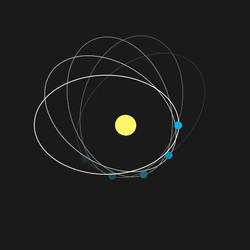|
In 1509 Copernicus developed the theory that the sun and not the Earth was the centre of the universe and that all the planets revolve around the sun in circles. Kepler improved on the theory, stating that circular orbits were special cases, and that most orbits were elliptical, and he also discovered the laws governing the motion of the planets.
On the basis of Kepler's work, Newton developed the theory of gravity. The methods of calculation and observation were continuously improved to check the congruence of theory and reality.
The elliptical orbits rotate and Newton's equations made it possible to calculate these rotations. But in the middle of the 19th century, Urbain Le Verrier discovered that the perihelion precession of Mercury was not 530 arcseconds per century, as calculated by Newton, but 43 arcseconds more. It was imperative to find an explanation for this, as for a precise science like astronomy, a deviation of 43 arcseconds per century was an inacceptable discrepancy between theory and reality. An explanation was sought; it was conjectured that another planet might lie in Mercury's orbit. Astronomers tried to find it during each solar eclipse. It was Einstein who ultimately found the explanation with his general theory of relativity. Newton's equations of motion were a borderline case of general relativity theory, applicable for small masses and velocities. But with increasing mass and velocity there are ever greater deviations bewteen Newton's and Einstein's calculations. In the case of the double pulsars PSR J0737-3039 the difference bewteen Newton's and Einstein's equations is as much as 16.9 degrees per year. 43 arcseconds deviation and an explanation is determinedly sought. That is science. Meanwhile the discrepancy between the claims of economic scientists and reality is already 180 degrees. |




